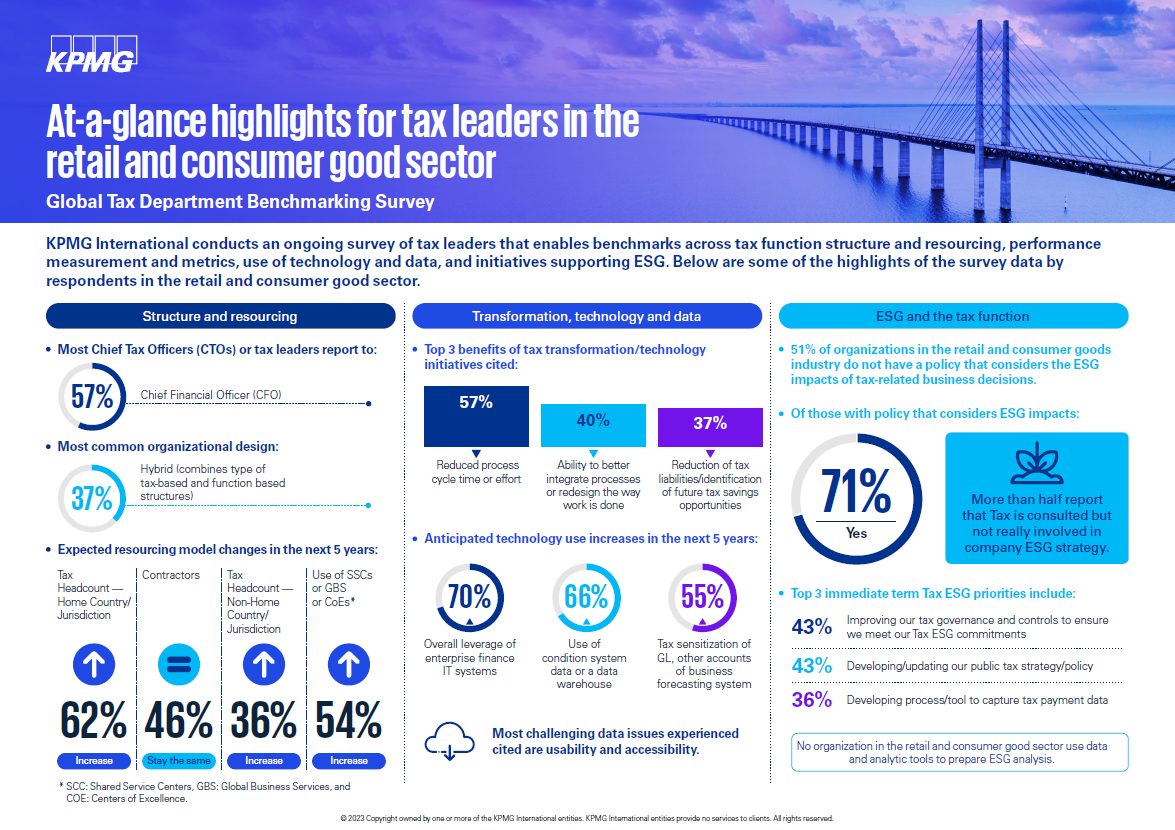How does your tax function stack up?
Seasoned tax leaders in the financial services sector make key decisions every day to evolve their tax function and keep pace with evolving pressures, disruptive technological advancements, heightened compliance obligations and more — all while seeking to demonstrate value within the organization and beyond.
Benchmarking against comparable financial services tax functions can be a powerful tool for reflecting on your organization's current position and planning how to prepare for the future. To help, KPMG International conducts an ongoing survey of the tax functions in multinational organizations around the world. The data gained offers insights into tax functions globally and how they are evolving in their structure, governance, priorities and performance measures, through the use of technology and more.
In this at-a-glance summary, we provide a look at some of the key findings relating to tax function structure and resourcing, transformation, technology and data, and ESG from survey respondents in the financial services sector.
KPMG Perspective:
Tax functions embrace technology transformation to enable value creation and operational efficiency
Survey responses from tax leaders in the financial services sector paint a picture of an industry continuing to face significant change, and tax functions navigating their organizations’ evolving business priorities and challenges.
From a resourcing perspective, these organizations appear to be balancing financial prudence, amidst difficult market conditions and a high interest rate environment, against the need to make investments to respond to ever-increasing tax requirements. They indicate that their staffing expectations for the next five years remain largely unchanged, with a potential increase in hiring at the home country level. In tandem, survey participants recognized the growing role that technology will play in how their tax function operates, as they indicated a desire to focus headcount growth in more value-added activities than before. Tax technology and transformation is clearly viewed as a primary way of driving process improvement, better data management, and the consequential benefit of being able to run better data analytics to drive efficiency. However, tax leaders also acknowledge that doing so is not without its challenges, particularly data accessibility.
The survey also reveals how tax functions are broadening their reach as business advisors, but there is more to do. With the implementation of significant complex changes in international law, such as BEPS Pillar 2, as well as a relentless focus on governance and risk, tax leaders understand that their ability to engage with senior management on tax matters has become critical. For instance, in the area of ESG, while some progress has been made in engaging the tax function in strategic ESG matters, they seek to strengthen internal policies, tools and controls to help the tax function deliver strategic value. These requirements are likely to grow in importance as the public disclosure of tax information enters into force. Although these issues are complex, it is encouraging that, overall, tax leaders have a solid appreciation of the need to enhance their people, process and technology capabilities in the near term, to both respond to change, and reap emerging opportunities, awaiting their sector.
Robin Walduck
Global Head of Financial Services Tax, KPMG International













